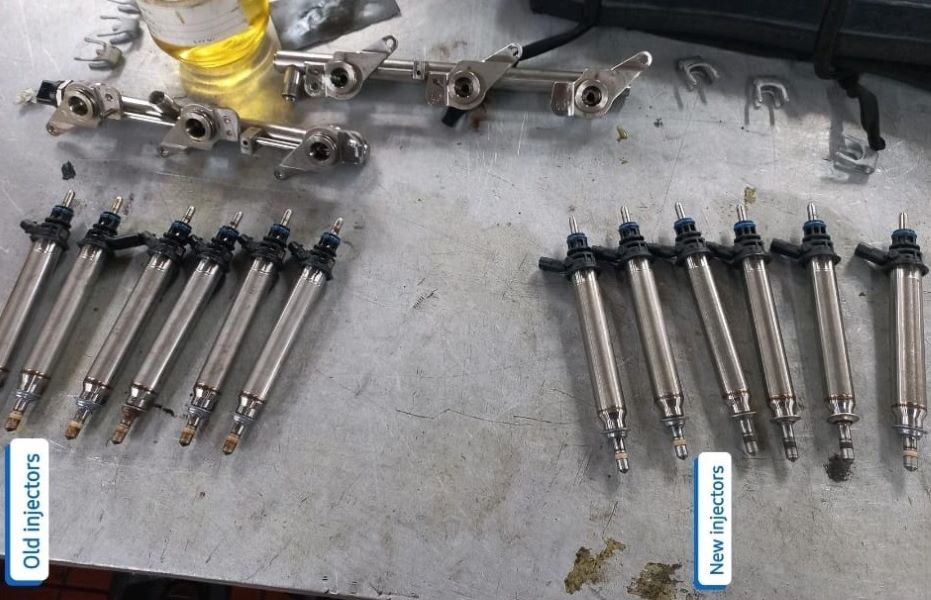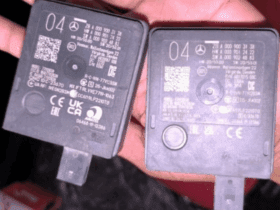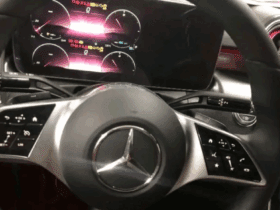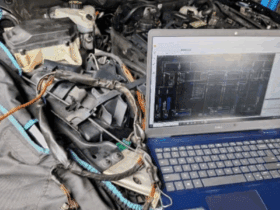Table of Contents
Car Starts Then Dies Immediately: Real Fix in a Mercedes-Benz CLS 350 (M276 Engine)
When your car starts then dies immediately, it’s not just annoying it’s a red flag. It signals that one or more systems in your vehicle aren’t working in sync, often involving fuel delivery, ignition, or air-fuel balance. This article explores a real case study of a Mercedes-Benz CLS 350 equipped with the M276 engine, which came into the workshop with this exact issue.
By walking through the step-by-step diagnosis, we’ll uncover how a simple-sounding complaint turned into a precise mechanical and electronic repair ending with a smooth-running V6 and a satisfied owner.
Vehicle Overview
| Model | Mercedes-Benz CLS 350 |
|---|---|
| Engine | M276 3.5-liter V6 Direct Injection |
| Symptom | Engine starts, shakes for a few seconds, then shuts off |
| Diagnostic Tool Used | XENTRY STAR Diagnosis |
Step 1: Customer Complaint “Car Starts Then Dies Immediately”
The owner reported:
“The car starts normally, runs roughly for a few seconds, shakes, and then shuts off.”
No unusual noises, no warning lights just a consistent start-and-stall behavior.
This type of issue can be caused by many systems, so the key was to proceed methodically rather than replacing parts at random.

Step 2: Quick Diagnostic Scan & Live Data
A quick scan using Mercedes-Benz XENTRY Diagnosis was performed.
- – No fault codes were stored in memory surprising at first.
- – Live data revealed misfire counts on cylinders 1 through 5 during startup.
This immediately pointed toward a combustion-quality problem rather than a crank or sensor issue. Since misfires were widespread, we suspected either poor ignition or inconsistent fueling.

Step 3: Ignition System Inspection
The ignition system was examined first because it’s fast, accessible, and often overlooked.
Findings:
- – Spark plugs showed heavy carbon fouling on the tips.
- – The plug gaps were inconsistent and outside manufacturer specifications.

Action:
- – All plugs were cleaned and re-gapped according to Mercedes specifications.

Result:
The engine started slightly smoother but still stalled after a few seconds.
Ignition quality improved, but the core issue persisted meaning fuel delivery or air mixture had to be next.
Step 4: “Mixture Too Lean” Fault Appears
After repeated starts, a new fault code appeared:
“Mixture too lean”
A lean mixture means the engine isn’t getting enough fuel relative to air, or extra unmetered air is entering the intake system.
Possible causes:
- – Vacuum leak (intake hose, gasket, or manifold leak)
- – Fuel delivery issue (injectors, fuel pressure, or pump)
To narrow it down, a smoke test was performed on the intake system.
Step 5: Intake System Smoke Test
A smoke leak detector was connected to the intake manifold.
After several minutes of pressurized testing no leaks were found.
The air side was perfectly sealed, ruling out cracked hoses or intake manifold leaks.
With air leaks eliminated, attention shifted fully to the fuel system.


Step 6: Fuel Injector Inspection
The M276 V6 engine uses piezoelectric direct injectors, mounted directly into the combustion chamber.
All six injectors were removed for inspection.
Findings:
- – Several injectors had uneven spray patterns and visible deposits.
- – The internal tips showed signs of leakage and fouling.
- – Some injectors were not delivering fuel consistently across all cylinders.
Since piezo injectors cannot be repaired or cleaned, the only solution was replacement.


Step 7: Replacing the Piezo Injectors
Procedure:
- 1. Depressurize the fuel system and remove the rail.
- 2. Replace all six OEM piezo injectors with new Mercedes-approved parts.
- 3. Fit new Teflon sealing rings and torque injectors to factory specifications.
- 4. Reinstall the rail, reconnect the electrical connectors, and check for leaks.
- 5. Adapt and code the new injectors using XENTRY to ensure proper ECU calibration.
Verification:
- – Performed a cold-start test while monitoring live misfire counters.
- – The engine ran smoothly, maintaining idle without shutting off.
- – No misfires detected and no lean codes returned.
Problem solved the car starts and stays running perfectly.


Step 8: Root Cause Summary
| Component | Status | Effect |
|---|---|---|
| Spark Plugs | Fouled, re-gapped | Minor improvement |
| Intake System | No leaks | Air side normal |
| Fuel Injectors | Faulty (piezo type) | Poor atomization → Lean mixture → Stall |
| ECU Codes | “Mixture too lean” (temporary) | Cleared after injector replacement |
Related Diagnostic Resource
If you’re facing similar starting problems, explore our full troubleshooting hub:
Mercedes No Start Issues: Causes, Fixes & Case Studies : a complete guide covering electrical, fuel, and ECU-related no-start scenarios across multiple Mercedes models.
Why Piezo Injectors Fail on the M276 Engine
The M276 engine relies on piezoelectric injectors, which open and close using electrical vibrations from stacked crystals. This technology allows extremely precise fuel control ideal for power and efficiency but also makes them sensitive to contamination.
Common causes of piezo injector failure:
- – Low-quality fuel (leaves deposits on nozzles)
- – Extended oil change intervals (oil vapors carbonize near injector tips)
- – Poor fuel filtration
- – Age-related wear of piezo stacks
Unlike solenoid injectors, piezo injectors:
- – Can’t be ultrasonically cleaned
- – Can’t be rebuilt
- – Must be replaced as units
In short: once spray pattern degradation begins, it only worsens with time.
Technical Insight: Why the Engine Stalled
When injectors under-deliver fuel:
- 1. The engine starts because enough fuel is injected for initial combustion.
- 2. As the ECU enters closed-loop operation, it tries to balance air-fuel mixture using sensor feedback.
- 3. The ECU detects lean exhaust gases → adjusts fuel trims → misfires increase.
- 4. Combustion becomes unstable, RPM drops, and the engine shuts down.
This sequence happens within seconds and that’s why a car starts, shakes, then dies.
Step 9: Post-Repair Verification
A final road test and live monitoring confirmed:
| Parameter | Before Repair | After Repair |
|---|---|---|
| Idle Stability | Rough → stalling | Smooth and steady |
| Misfire Counts | Cyl 1–5 active | Zero |
| Fuel Trim | Lean (+18%) | Normal (±2%) |
| DTCs | “Mixture too lean” | None |
The customer reported that the car now starts instantly and idles flawlessly even in cold conditions.
Key Takeaways
- – “Car starts then dies immediately” almost always points to fuel delivery or air-fuel balance issues.
- – In direct-injection engines, injectors are prime suspects even without fault codes.
- – Always use live misfire counters and smoke tests don’t replace parts blindly.
- – Piezo injectors on the M276 are not serviceable; replacement is the correct fix.
- – After replacement, always code injectors to ensure proper ECU adaptation.
FAQs: Car Starts Then Dies Immediately
Can bad fuel injectors cause a car to start and then die?
Yes. Faulty or clogged injectors restrict fuel flow, creating a lean mixture that can’t sustain combustion. The ECU compensates, but when mixture correction exceeds limits, the engine stalls. In this case, replacing worn piezo injectors fixed the issue.
Can spark plugs cause a start-and-stall symptom?
They can contribute. Fouled or incorrectly gapped plugs produce weak sparks, especially during cold starts. They may not be the primary cause, but they amplify misfires from other faults.
Which sensors can cause a car to stall right after starting?
If sensors like the MAF, crankshaft, or camshaft position sensor send implausible signals, the ECU may cut fuel or spark to protect the engine. However, in this case study, all sensor data was normal.
How do I fix a car that starts then dies immediately?
Use a systematic process:
- 1. Scan for fault codes.
- 2. Inspect spark plugs.
- 3. Check fuel pressure and injector function.
- 4. Perform a smoke test for leaks.
- 5. Test sensors if no mechanical issue is found.
Avoid guessing diagnostics saves time and prevents costly mistakes.
Author Bio
Written by Mercedes Expert
With years of hands-on experience diagnosing and repairing Mercedes-Benz systems, he brings technical depth and practical case studies to help car owners, technicians, and enthusiasts troubleshoot complex automotive issues. His work focuses on clear repair guides, OEM-level procedures, and knowledge-sharing to empower both professionals and drivers.
Last update: October 2025






Leave a Reply